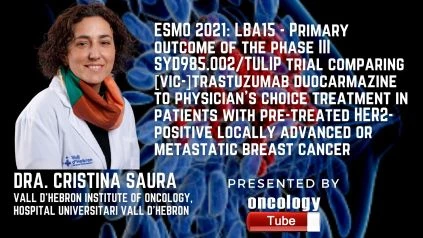Saura Manich from the Department of Medical Oncology, Vall d’Hebron Institute of Oncology (VHIO), Hospital Universitari Vall d’Hebron speaks about ESMO 2021 Abstract – LBA15 – Primary outcome of the phase III SYD985.002/TULIP trial comparing [vic-]trastuzumab duocarmazine to physician’s choice treatment in patients with pre-treated HER2-positive locally advanced or metastatic breast cancer.
LBA15 Abstract:
Background:
[vic-]Trastuzumab duocarmazine (SYD985, Byondis B.V., NL) is a new HER2-targeting antibody–drug combination made up of trastuzumab linked to a duocarmycin-containing linker molecule. TULIP looked at SYD985’s effectiveness in advanced HER2-positive breast cancer.
Methods:
The TULIP study (NCT03262935) randomly allocated HER2-positive locally advanced or metastatic breast cancer (MBC) patients with at least two previous MBC regimens or previous MBC treatment with T-DM1 to one of two groups: SYD985 (1.2 mg/kg q three weeks) or PC chemotherapy. By blinded central review, the main outcome was progression-free survival (PFS). The study was designed to identify a Hazard Ratio (HR) of 0.65 at a significance threshold of P 0.05. Investigator-assessed PFS, overall survival (OS), objective response rate (ORR), and health-related quality of life were secondary goals (HRQoL).
Results:
SYD985 (n=291) or PC (n=146) were given to 437 patients from 11 countries. The average age was 56, and the average number of previous MBC treatments was 4 [range 1-16]. SYD985 had a median PFS of 7.0 months [95 percent CI 5.4-7.2] while PC had a median PFS of 4.9 months [4.0-5.5] (HR 0.64 [0.49-0.84]; p = 0.002). PFS was also improved considerably (6.9 months [6.0-7.2] vs 4.6 months [4.0-5.6]; HR 0.60 [0.47-0.77]; p 0.001). The HR in this initial OS analysis was 0.83 [0.62-1.09]; p = 0.153. ORR and HRQoL did not show any significant differences. Conjunctivitis (38.2%), keratitis (38.2%), and tiredness (33.3%) were the most often reported adverse effects for SYD985, whereas diarrhoea (35.8%), nausea (31.4%), and weariness (33.3%) were the most frequently reported adverse events for PC (29.9 percent ). Interstitial lung disease/pneumonitis was documented in 7.6% of patients treated with SYD985 (5.2 percent grade 1-2), with two grade 5 occurrences. The most common adverse events that led to discontinuation (SYD985 35.4 percent, PC 10.2 percent) in the SYD985 group were eye problems (20.8 percent) and respiratory disorders (10.2%). (6.3 percent ).
Conclusions:
In compared to conventional PC, SYD985 therapy increased PFS substantially, suggesting that it might be a novel therapeutic option for patients with pre-treated locally progressed or metastatic HER2-positive MBC.
Clinical trial identification
NCT03262935.

